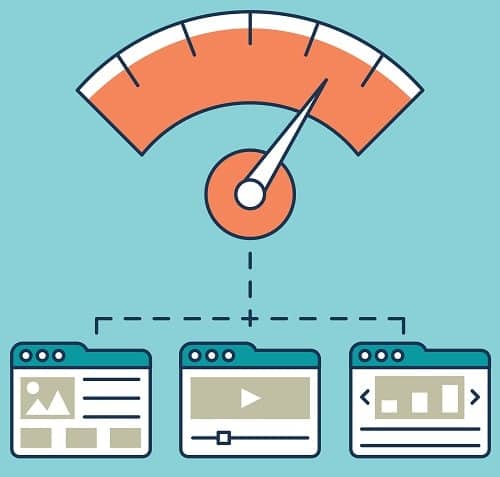Recently, Google dished out their “Speed Update”, a new set of changes that modifies the way their invaluable search algorithm displays results. You may not know that this could actually impact your results, meaning fewer people on your website, and fewer customers through your doors.
But don’t fret, because there are things you can do to keep your ranking from tanking, and that’s just what we’ll look at in this post.
What Is the Google Speed Update?
 Before going on further, we should begin the simplest way possible, discussing what the update is meant to do from the point of view of Google and its search engine.
Before going on further, we should begin the simplest way possible, discussing what the update is meant to do from the point of view of Google and its search engine.
The Speed Update is a new ranking algorithm that has been designed specifically for mobile search. SEOs have known for years already that Google took speed into account for its desktop ranking, but this marks the first time there will be an impact on mobile ranking.
According to Google, the change will only affect a small number of pages and will apply the same standard to all of its results. Big G has also recommended a few tools to get an idea of how well your website is performing (or not!).
Measuring Tools
The first of the tools is the Chrome User Experience Report, which is a public dataset of user experience metrics, working with the results of real Chrome users going on popular sites.
The second is Lighthouse, which is an automated tool that forms part of the Chrome Developer Tools. Its focused on measuring the quality (such as performance and accessibility) of your website.
Last, but not least, is PageSpeed Insights, a tool that tells how a normal page performs with the Chrome UX Report while suggesting certain modifications to improve the load time.
How Will the Google Speed Update Impact My Website?
Thanks to the previous tools, you should have a good idea of how your site is performing and how it might affect the ranking in mobile results.
For those that have been constantly improving their mobile experience and their page load speed, there should be no significant changes in traffic. Once again, Google said this will affect very few sites.
On the other hand, if you’ve been slacking on improving your mobile page speed, you need to go ahead and change that quickly. The changes to the algorithm are coming, and they’re going to affect you. Because smaller businesses don’t have the same budget for web development and improvement as big companies, they’re going to be the ones most affected by the change.
Improving Your Page Speed on Mobile
Here are some tips and ideas so that you can improve your load speed and not take a big hit from the Google Speed Update.
Optimize Images
 Large, high-definition images are usually the part of the webpage that takes the most time to load. Given the improvement in the resolution and the size of most mobile screens, you definitely want to show potential customers the best look for your business. Sadly, these might be the things that have been affecting you most.
Large, high-definition images are usually the part of the webpage that takes the most time to load. Given the improvement in the resolution and the size of most mobile screens, you definitely want to show potential customers the best look for your business. Sadly, these might be the things that have been affecting you most.
The first thing you can do to fight this is to use a CMS plugin to automatically compress uploaded images to reduce their file size and their weight, all the while giving the user a good experience. You can also use CSS and load images in the background, using media queries to show them or hide them, depending on the device.
Lose the Redirects
Whenever you click on a link and your browser has to be redirected from the entered URL to another one, more load time is added to the webpage. This additional time matters most on mobile devices, as they tend to be connected on networks with slower speed.
The most common of these redirects is a 301, which can really pile up and make your webpage a lot slower, especially if you have to regularly archive pages and instead push your users into top-level pages. This is probably one of the hardest issues to deal with, given that a 301s could be necessary for your website to function.
Even if Google encourages webmasters to reduce the number of redirects, and to ideally eliminate them entirely, having a redirect-free site is going to be very hard. Especially if you have a very large website that’s been slowly built up for years.
To solve this issue (or to at least help alleviate it) you can use tools like Vary’s Redirect Mapper that will analyze your pages and discover the redirects that can be eliminated to optimize page load speed.
Server Response Time
The term “Time to the first byte” (TTFB) is the amount of time it takes for your server to return a response, which you obviously want to be as low as possible for a quick page load time.
You can improve your web server software or your configuration and ensure that there are adequate memory and CPU resources available as some steps to somewhat improve your server response time.
We can’t really go into details here, given that it depends a lot on the configuration of your servers, but taking the time to analyze server response time and making sure it’s not a factor in having a low page load speed is definitely going to be worth it.
Prioritize Visible Content.
 Getting your website to first load all of the content that the user will is something very important that Google has already highlighted in their HTML Service: Best Practices documents. Usually, this is above the fold content, and most likely there’s less of it on mobile devices in comparison to desktops, due to the difference in screen size.
Getting your website to first load all of the content that the user will is something very important that Google has already highlighted in their HTML Service: Best Practices documents. Usually, this is above the fold content, and most likely there’s less of it on mobile devices in comparison to desktops, due to the difference in screen size.
Check your web pages to make sure that they’re coded to tell the server that it should send the data to display above the fold content first, while the rest of the page loads in the background. Assuming the site isn’t trying to load a full page immediately, this should help reduce the point in which content begins to appear on the screen.
Consider AMP
Pages that have a lot of content could benefit from being coded as Accelerated Mobile Pages (or AMP), which means that Google will load it outside of your website with navigation and dynamic features.
AMP doesn’t come without costs though. AMP pages have limited functionality and don’t count as a normal page view. So you need to decide if your page going to attract your visitor enough to want to browse the rest of your site.
Are You Ready For the Update?
This list is not meant to be exhaustive. There are plenty of other options you can take to improve page load speed. But the most important thing to remember is this: the worst action to take is to do nothing.
If you don’t know where to start, or if you’re looking for someone to do the hard work for you, reach out to ShiftWeb today.
